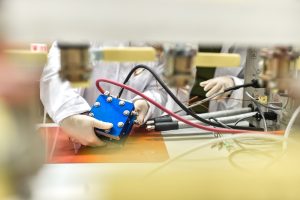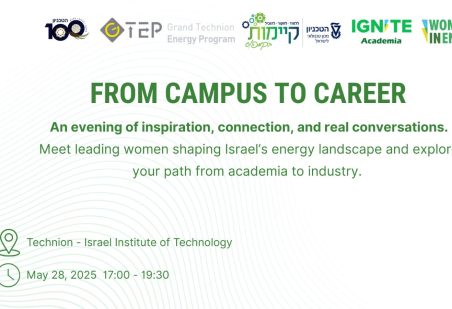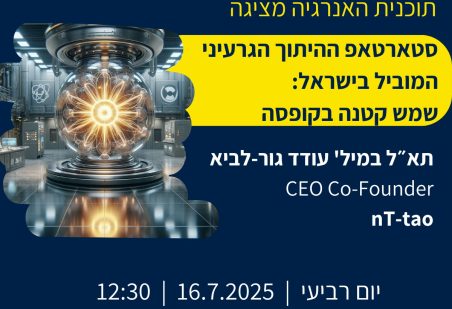| In 2007, a forum for energy efficiency was appointed that began activities to reduce greenhouse gas emissions and energy savings at the Technion. The Forum carries out many activities that include operating a savings plan in the various units, promoting measures for saving and energy efficiency, including replacing refrigeration units (chillers), participating in state tenders to reward energy efficiency, installing solar cells, outdoor lighting control based on an astronomical clock, replacing lighting solutions for LEDs, installing presence detectors, control systems and more. |
Savings activity
About a decade and a half ago, the Forum began to operate a program for energy savings and efficiency. The program encourages energy savings (mainly electricity and diesel fuel) and is based on a unique streamlining model that divides the financial savings from the activity between the Technion and the participating unit. The program has created a wide echo and institutions outside the Technion come to learn about its principles.
Initially, the program was implemented experimentally with the Faculty of Electrical Engineering. And in light of the impressive achievements, it was decided to expand it. Over the years, additional units have been added and today there are 19 units in the energy efficiency agreement with cumulative savings of over NIS 50 million.
The participating faculties – electrical, physics, computer science, civil, biology, science teaching, Canada Building, Solid State, Ullmann, Mathematics, Architecture, Machinery, Aeronautics, IAI, Asher Institute, Faculty Club, Chemical Engineering, Biotechnology and Food, Biomedicine.
Click here to read about the energy efficiency project at the Technion.
Replacing chillers
The Technion has air conditioning systems (chillers) that were installed twenty years or more ago, with an old 22R gas that is dangerous to the environment that is substandard. Each period, a number of chillers are exchanged for new, efficient, economical and environmentally friendly gas. To date, about 20 chillers have been replaced at a cost of about 20 million NIS – in the student house, solid state, biology, biomedicine, computer science, chemistry, Liddy Davis, the workers’ club, the Canada Amado building and more.
Participation in state tenders for remuneration for streamlining
Every year to two years, the state distributes tenders for remuneration for the work of replacing chillers, and other solutions for energy efficiency. Since 2012, the Technion has participated in 7 tenders (one did not win and one is awaiting results) in which work was carried out to replace lighting fixtures for LEDs, installation of control systems for hoods and main activity to replace old cooling systems (chillers) with substandard gas in more efficient systems with environmentally friendly gas.
To date, the Technion has received compensation of 2.7 million NIS.
Solar Cells
In order to produce clean and non-biodegradable energy at the Technion, to reduce electricity consumption from the national electricity grid and hence to reduce greenhouse gas emissions, in 2018, the first system of solar cells – PV (Photo Voltaic) with a capacity of KWP50 was established on the roof of the Nano Electronics building. The system is unique and consists of 4 different technologies and is used for electricity generation and research.
In 2020, two more solar cell systems were built in the Ullmann KWP100 building and on the roof of the student house building with a capacity of KWP200, and the Technion intends to build another KWP140 system on the roof of the Central Library.
 |
 |
 |
| Ullman building | Nano Electronics building | Student House |
Replacement for LED lighting
For the past decade, all the lighting fixtures installed at the Technion in every renovation and in new buildings are economical LED lighting. Interior installation lighting fixtures for classrooms, offices, laboratories, etc., as well as outdoor lighting. In addition, every year, hundreds of indoor/outdoor lighting fixtures are proactively replaced with wasteful technologies for LED lighting fixtures.
Water and electricity stock
To save electricity and water in the student dormitories at the Technion, meters were installed. Most of them are for remote reading of electricity and water consumption and a small number are still in manual reading. Thus, electricity consumption is divided among the students who live in each apartment (according to the calculation of daily consumption). Each month, about 4,000 electricity and water bills are generated for student billing.
In the same way, external tenants are charged electricity consumption each month. Total collection cost of approximately NIS 7 million each year.
Outdoor lighting control
For control of the outdoor lighting system and for the safety of the users of the campus, a wireless system has been installed for remote control of the outdoor lighting. The system is based on an astronomical clock with the possibility of real-time control on a GIS map. Through it, it is possible to diagnose problems and malfunctions in the outdoor lighting. To date, 28 main outdoor lighting switchboards have been installed, covering about 80% of campus lighting.
Purchasing green electricity
The Technion purchases the electricity from a private electricity supplier RAPAC, which generates electricity through natural gas-powered turbines that are free of coal and diesel fuel, and at a discount from iec electricity tariffs. In this way, the Technion contributes to cleaner air and saves a lot of money in its ongoing expenditure.
Replacement of diesel and fuel oil systems for heat pumps
In recent years, the Technion has replaced water heating systems produced through the use of diesel and fuel oil heating boilers, with electric heat pumps – chillers. The heat pumps produce hot water efficiently, at a low cost and by using much cleaner energy than fossil fuels and pollutants throughout the campus.
To date, systems in buildings have been replaced – biology, biomedicine, microelectronics, chemistry and Lady Davis.
Voluntary reporting of greenhouse gas emissions
The Technion campus reports annually to the Ministry of Environmental Protection on all greenhouse gas emissions generated under Scope 1.
To read the full article click here.
Research program
The Grand Technion Energy Program (GTEP) was set out to foster basic and applied multi-disciplinary energy research and advance graduate education in energy, leading to the adoption of clean and efficient energy technologies. The GTEP MISSION is to advance research in energy fields by supporting ambitious projects with global impact, to promote multidisciplinary cooperation, attract new faculty and top graduate students, investing in the promotion and development of appropriate infrastructure and strengthen academic and industrial national and international collaborations.
The Nancy and Stephen Grand Technion Energy Program is bringing together the best science and engineering researchers to work in a broad interdisciplinary track to discover and exploit alternative and renewable energy sources, to search for and develop alternative non-carbon based fuels, to seek solutions for more efficient energy use, and to reduce the environmental damage caused by the production and burning of fossil fuels.
GTEP was established in 2007 to spur multi-disciplinary research and to educate world-class scientists. Since then, GTEP has evolved into a dynamic national hub that has been making a significant impact both within the Technion and throughout the national and global scientific community. GTEP activities and support in research and education has produced major scientific discoveries, some of which have led to the establishment of promising start-up companies, forged strong industrial and academic ties in Israel and abroad, and attracted first rate faculty members and students.
For more details about the program click here.







